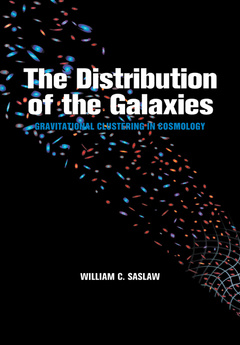The Distribution of the Galaxies Gravitational Clustering in Cosmology
Langue : Anglais
Auteur : Saslaw William C.

This volume, first published in 2000, examines one of the leading problems in astronomy today - how galaxies cluster in our Universe.
This topical volume examines one of the leading problems in astronomy - how galaxies cluster in our Universe. This book, first published in 2000, describes gravitational theory, computer simulations and observations related to galaxy distribution functions. It embeds distribution functions in a broader astronomical context, including other exciting contemporary topics such as correlation functions, fractals, bound clusters, topology, percolation and minimal spanning trees. Key results are derived and the necessary gravitational physics provided to ensure the book is self-contained. Throughout the book, theory, computer simulation and observation are carefully interwoven and critically compared. The book also shows how future observations can test the theoretical models for the evolution of galaxy clustering at early times in our Universe. This clear and authoritative volume is written at a level suitable for graduate students, and will be of key interest to astronomers, cosmologists, physicists and applied statisticians.
Prologue; Part I. Historical: 1. Cosmology myths and primitive notions; 2. First qualitative physics: the Newton-Bentley exchange; 3. Glimpses of structure; 4. Number counts and distributions; 5. Seeds of grand creation; 6. Clusters versus correlations; 7. The expanding search for homogeneity; Part II. Descriptions of Clustering: 8. Patterns and illusions; 9. Percolation; 10. Minimal spanning trees; 11. Topology; 12. Fractals; 13. Bound clusters; 14. Correlation functions; 15. Distribution functions; Part III. Gravity and Correlation Functions: 16. The growth of correlations: I. A fluid description; 17. The growth of correlations: II. A particle description; 18. General correlation properties; 19. Computer simulations; 20. Simulations and observations of two-particle correlations; Part IV. Gravity and Distribution Functions: 21. General properties of distribution functions; 22. Dynamics of distribution functions; 23. Short review of basic thermodynamics; 24. Thermodynamics and gravity; 25. Thermodynamic formulation of the cosmological many-body problem; 26. The functional form of b(n,T); 27. Derivation of the spatial distribution function; 28. Properties of the spatial gravitational quasi-equilibrium distribution; 29. The velocity distribution function; 30. Evolution of the GQED; Part V. Computer Experiments for Distribution Functions: 31. Spatial distribution functions; 32. Velocity distribution functions; Part VI. Observations of Distribution Functions: 33. Observed spatial distribution functions; 34. Observed peculiar velocity distribution functions; 35. Observed evolution of distribution functions; Part VII. Future Unfoldings: 36. Galaxy merging; 37. Dark matter again; 38. Initial states; 39. Ultimate fates; 40. Epilogue; Bibliography; Index.
Date de parution : 02-2008
Ouvrage de 524 p.
17x24.2 cm
Thème de The Distribution of the Galaxies :
© 2024 LAVOISIER S.A.S.



